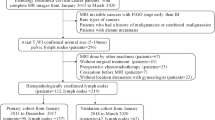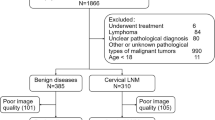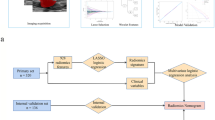Abstract
Objective
To investigate the feasibility of a noninvasive detection of lymph node metastasis (LNM) for early-stage cervical cancer (ECC) patients with radiomics methods based on the textural features from ultrasound images.
Methods
One hundred seventy-two ECC patients between January 2014 and September 2018 with pathologically confirmed lymph node status (LNS) and preoperative ultrasound images were retrospectively reviewed. Regions of interest (ROIs) were delineated by a senior radiologist in the ultrasound images. LIFEx was applied to extract textural features for radiomics study. Least absolute shrinkage and selection operator (LASSO) regression was applied for dimension reduction and for selection of key features. A multivariable logistic regression analysis was adopted to build the radiomics signature. The Mann–Whitney U test was applied to investigate the correlation between radiomics and LNS for both training and validation cohorts. Receiver operating characteristic (ROC) curves were applied to evaluate the accuracy of the radiomics prediction models.
Results
A total of 152 radiomics features were extracted from ultrasound images, in which 6 features were significantly associated with LNS (p < 0.05). The radiomics signatures demonstrated a good discrimination between patients with LNM and non-LNM groups. The best radiomics performance model achieved an area under the curve (AUC) of 0.79 (95% confidence interval (CI), 0.71–0.88) in the training cohort and 0.77 (95% CI, 0.65–0.88) in the validation cohort.
Conclusions
The feasibility of radiomics features from ultrasound images for the prediction of LNM in ECC was investigated. This noninvasive prediction method may be used to facilitate preoperative identification of LNS in patients with ECC.
Key Points
• Few studied had investigated the feasibility of radiomics based on ultrasound images for cervical cancer, even though it is the most common practice for gynecological cancer diagnosis and treatment.
• The radiomics signatures based on ultrasound images demonstrated a good discrimination between patients with and without lymph node metastasis with an area under the curve (AUC) of 0.79 and 0.77 in the training and validation cohorts, respectively.
• The radiomics model based on preoperative ultrasound images has the potential ability to predict lymph node status noninvasively in patients with early-state cervical cancer, so as to reduce the impact of invasive examination and to optimize the treatment choices.





Similar content being viewed by others
Abbreviations
- AUC:
-
Area under the curve
- CE:
-
Contrast-enhanced
- CI:
-
Confidence interval
- CT:
-
Computed tomography
- ECC:
-
Early-stage cervical cancer
- ECCR:
-
Ethics Committee in Clinical Research
- FIGO:
-
International Federation of Gynecology and Obstetrics
- GLCM:
-
Gray-level co-occurrence matrix
- GLRLM:
-
Gray-level run length matrix
- GLZLM:
-
Grey-level zone length matrix
- LASSO:
-
least absolute shrinkage and selection operator
- LNM:
-
Lymph node metastasis
- LNS:
-
Lymph node status
- MRI:
-
Magnetic resonance imaging
- NGLDM:
-
Neighborhood gray-level different matrix
- PACS:
-
Picture archiving and communication system
- PET/CT:
-
Positron emission tomography/computed tomography
- ROC:
-
Receiver operating characteristic
- ROI:
-
Region of interest
- SLN:
-
Sentinel lymph node
- SVM:
-
Support vector machine
References
Torre LA, Bray F, Siegel RL, Ferlay J, LortetTieulent J, Jemal A (2015) Global cancer statistics, 2012. CA Cancer J Clin 65:87–108
Biewenga P, van der Velden J, Mol BW et al (2011) Prognostic model for survival in patients with early stage cervical cancer. Cancer 117:768–776
Bourgioti C, Chatoupis K, Moulopoulos LA (2016) Current imaging strategies for the evaluation of uterine cervical cancer. World J Radiol 8:342
Plante M, Renaud MC, Têtu B, Harel F, Roy M (2003) Laparoscopic sentinel node map-ping in early-stage cervical cancer. Gynecol Oncol 91:494–503
Matsuura Y, Kawagoe T, Toki N, Tanaka M, Kashimura M (2010) Long-standing complications after treatment for cancer of the uterine cervix clinical significance of medical examination at 5 years after treatment. Int J Gynecol Cancer 16:294–297
Gien LT, Covens A (2009) Lymph node assessment in cervical cancer: prognostic and therapeutic implications. J Surg Oncol 99:242–247
Ferrandina G, Anchora LP, Gallotta V et al (2017) Can we define the risk of lymph node metastasis in early-stage cervical cancer patients? A large-scale, retrospective study. Ann Surg Oncol 24:2311–2318
Macdonald MC, Tidy JA (2016) Can we be less radical with surgery for early cervical cancer? Curr Oncol Rep 18:16
Diaz JP, Gemignani ML, Pandit-Taskar N et al (2011) Sentinel lymph node biopsy in the management of early-stage cervical carcinoma. Gynecol Oncol 120:347–352
Lecuru F, Mathevet P, Querleu D et al (2011) Bilateral negative sentinel nodes accurately predict absence of lymph node metastasis in early cervical cancer: results of the SENTICOL study. J Clin Oncol 29:1686–1691
Cross MJ (2007) Different criteria for radioactive sentinel lymph nodes has different impact on sentinel node biopsy in breast cancer patients. J Surg Oncol 95:616–617
Liu J, Wang Z, Shao H, Qu D, Liu J, Yao L (2018) Improving CT detection sensitivity for nodal metastases in oesophageal cancer with combination of smaller size and lymph node axial ratio. Eur Radiol 28:188–195
Williams AD, Cousins C, Soutter WP et al (2001) Detection of pelvic lymph node metastases in gynecologic malignancy: a comparison of CT, MR imaging, and positron emission tomography. AJR Am J Roentgenol 177:343–348
Gillies RJ, Kinahan PE, Hricak H (2015) Radiomics: images are more than pictures, they are data. Radiology 278:563–577
Han L, Zhu Y, Liu Z et al (2019) Radiomic nomogram for prediction of axillary lymph node metastasis in breast cancer. Eur Radiol 29:3820–3829
Wu S, Zheng J, Li Y et al (2018) Development and validation of an MRI-based radiomics signature for the preoperative prediction of lymph node metastasis in bladder cancer. EBioMedicine. 34:76–84
Mu W, Chen Z, Liang Y et al (2015) Staging of cervical cancer based on tumor heterogeneity characterized by texture features on 18F-FDG PET images. Phys Med Biol 60:5123
Liu Y, Zhang Y, Cheng R et al (2019) Radiomics analysis of apparent diffusion coefficient in cervical cancer: a preliminary study on histological grade evaluation. J Magn Reson Imaging 49:280–290
Lucia F, Visvikis D, Vallières M et al (2019) External validation of a combined PET and MRI radiomics model for prediction of recurrence in cervical cancer patients treated with chemoradiotherapy. Eur J Nucl Med Mol Imaging Res 46:864–877
Ho JC, Allen PK, Bhosale PR et al (2017) Diffusion-weighted magnetic resonance imaging as a predictor of outcome in cervical cancer after chemoradiation. Int J Radiat Oncol Biol Phys 97:546–553
Pascual MA, Graupera B, Hereter L, Rotili A, Rodriguez I, Alcazar JL (2011) Intra-and interobserver variability of 2D and 3D transvaginal sonography in the diagnosis of benign versus malignant adnexal masses. J Clin Ultrasound 39:316–321
Nioche C, Orlhac F, Boughdad S et al (2018) LIFEx: a freeware for radiomic feature calculation in multimodality imaging to accelerate advances in the characterization of tumor heterogeneity. Cancer Res 78:4786–4789
Friedman J, Hastie T, Tibshirani R (2010) Regularization paths for generalized linear models via coordinate descent. J Stat Softw 33:1
Han X, Wen H, Ju X et al (2017) Predictive factors of para-aortic lymph nodes metastasis in cervical cancer patients: a retrospective analysis based on 723 para-aortic lymphadenectomy cases. Oncotarget 8:51840–51847
Li D, Cai J, Kuang Y et al (2012) Surgical-pathologic risk factors of pelvic lymph node metastasis in stage Ib1-IIb cervical cancer. Acta Obstet Gynecol Scand 91:802–809
Cibula D, Zikan M, Slama J et al (2016) Risk of micrometastases in non-sentinel pelvic lymph nodes in cervical cancer. Gynecol Oncol 143:83–86
Shen WC, Chen SW, Liang JA, Hsieh TC, Yen KY, Kao CH (2017) [18] Fluorodeoxyglucose positron emission tomography for the textural features of cervical cancer associated with lymph node metastasis and histological type. Eur J Nucl Med Mol Imaging 44:1721–1731
Kan Y, Dong D, Zhang Y et al (2019) Radiomic signature as a predictive factor for lymph node metastasis in early-stage cervical cancer. J Magn Reson Imaging 49:304–310
Wang T, Gao T, Yang J et al (2019) Preoperative prediction of pelvic lymph nodes metastasis in early-stage cervical cancer using radiomics nomogram developed based on T2-weighted MRI and diffusion-weighted imaging. Eur J Radiol 114:128–135
Li K, Sun H, Lu Z et al (2018) Value of [18F] FDG PET radiomic features and VEGF expression in predicting pelvic lymphatic metastasis and their potential relationship in early-stage cervical squamous cell carcinoma. Eur J Radiol 106:160–166
Liu T, Zhou S, Yu J et al (2019) Prediction of lymph node metastasis in patients with papillary thyroid carcinoma: a radiomics method based on preoperative ultrasound images. Technol Cancer Res Treat 18:1533033819831713
Chicklore S, Goh V, Siddique M, Roy A, Marsden PK, Cook GJ (2013) Quantifying tumour heterogeneity in 18 F-FDG PET/CT imaging by texture analysis. Eur J Nucl Med Mol Imaging Res 40:133–140
Yu YY, Zhang R, Dong RT et al (2019) Feasibility of an ADC-based radiomics model for predicting pelvic lymph node metastases in patients with stage IB–IIA cervical squamous cell carcinoma. Br J Radiol 92(1097):20180986
Becker AS, Ghafoor S, Marcon M et al (2017) MRI texture features may predict differentiation and nodal stage of cervical cancer: a pilot study. Acta Radiol Open 6:2058460117729574
Funding
This work was partially funded by the National Natural Science Foundation of China (under Grant No. 11675122) and the Wenzhou Municipal Science and Technology Bureau (Nos. Y20190183 and 2018ZY016).
Author information
Authors and Affiliations
Corresponding authors
Ethics declarations
Guarantor
The scientific guarantor of this publication is Congying Xie.
Conflict of interest
The authors declare that they have no conflicts of interest.
Statistics and biometry
One of the authors has significant statistical expertise.
Informed consent
Written informed consent was waived by the institutional review board.
Ethical approval
Institutional review board approval was obtained.
Methodology
• Retrospective
• Observational
• Performed at one institution
Additional information
Publisher’s note
Springer Nature remains neutral with regard to jurisdictional claims in published maps and institutional affiliations.
Electronic supplementary material
ESM 1
(DOCX 112 kb)
Rights and permissions
About this article
Cite this article
Jin, X., Ai, Y., Zhang, J. et al. Noninvasive prediction of lymph node status for patients with early-stage cervical cancer based on radiomics features from ultrasound images. Eur Radiol 30, 4117–4124 (2020). https://doi.org/10.1007/s00330-020-06692-1
Received:
Revised:
Accepted:
Published:
Issue Date:
DOI: https://doi.org/10.1007/s00330-020-06692-1




